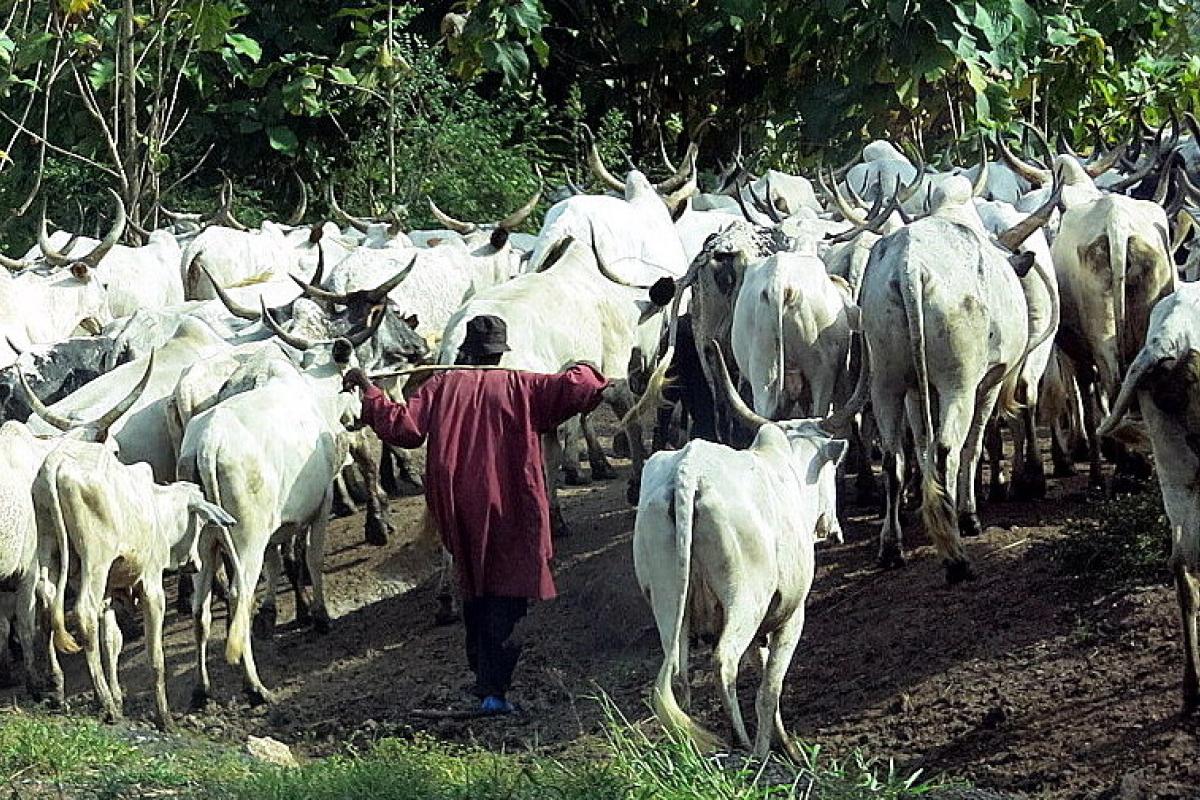
The foe of an old adversary is not necessarily a friend
The Nanung Traditional Area in Northern Ghana is notorious for conflicts of varying proportions. These include chieftaincy, ethnic, and resource conflicts. In this blogpost Osman Alhassan from the University of Ghana describes how two different conflicts, the chieftancy conflict and the farmer-herder conflict are woven into people’s everyday lives in the town of Bimbilla – even though they are not always consciously aware. It is based on fieldwork carried out with Domestic Security Implications of Peacekeeping in Ghana (D-SIP).
For many people in Bimbilla it is the chieftaincy conflict between two factions for occupancy of the Bimbilla skin (position of chief) that is most concerning. A key respondent during interviews held in Bimbilla described it as the most negative and divisive issue in the area in the last two decades. Since 1999, frequent violent conflicts between the Andani and Abudulai families over the Bimbilla position of chief have been reported copiously in the Ghanaian media. Although two settlements in the area, Bimbilla and Dokpam, are the epicentre of this conflict, having seen serious battles in the past two decades, entire communities have been sucked into the chieftaincy divide and conflicts that have torn Nanung and Bimbilla apart.
It was not surprising therefore, that some of our respondents played down the Fulani herdsmen-farmer conflicts in the area. And yet, as we interacted with people in casual conversations on the streets of Bimbilla, some acknowledged the importance of herder-farmer conflicts which have affected other spheres of life beyond the arenas of confrontation.
This paradox of an almost total focus on one conflict that downplays other equally serious tensions has its roots in the history of an earlier conflict in the Bimbilla area between the Nanumba and Konkomba, who were embroiled in two wars – the first in 1981 and the second in 1994. These were devastating in terms of human casualties, property loss and human dislocation mostly to Yendi, Tamale and other cities such as Kumasi and Accra. The effects of the second conflict in 1994 are still visible even after 25 years. During these conflicts, the Nanumba found Bimbilla and other bigger settlements as safe haven, while the Konkomba found the distant rural areas as safer ground. This resulted in the spatial redistribution of the two ethnic groups, the Nanumba in the major Nanung settlements, and the Konkomba in the rural areas surrounding Bimbilla (now Nanumba North) and Wulensi (now Nanumba South). It has had a direct impact on how the two groups view the herdsmen-farmer conflicts.
Although the exact time when the local crop farmers in the Bimbilla area started having problems with the nomadic Fulani is not exactly clear, media reports seem to suggest that the area started experiencing clashes between farmers and Fulani herders some years before the initial launch of Operation Cow Leg in 1988 (a joint military-police operation). As the Konkomba now largely occupy farming lands in the rural outskirts of Bimbilla, they are the ones in constant touch with the nomadic herdsmen who are mostly located in the distant rural areas where they can have adequate grass and water for their cattle. Indeed, media reports suggest that all the rural areas within the east and west boundaries of the Bimbilla-Damanko-Kpasa stretch have had some of the most intensive clashes between local farmers and Fulani herdsmen.
Bimbilla, on the other hand is now mostly urban, with a population of 25,675 residents as of 2010, and many who reside in the town and its immediate sprawl do not engage in subsistence farming as their main occupation. They are involved in urban livelihoods such as food processing and vending, trading and other artisanal enterprises providing various services to residents. Their main concern is with the chieftaincy conflict which often bring them hardship; one which field respondents frequently mentioned was the long curfews they have had to endure since 2016. Women in Bimbilla said the curfew has disrupted their livelihood sources in a big way since limited movement restricts trade, including the volume of foodstuffs and other essentials that can be brought into Bimbilla. At the time of our field visit to Bimbilla in early 2019, the town had been under a four-year curfew, and though it was said to have been relaxed over time, residents found the prevailing curfew between 10PM and 4AM detrimental to business and livelihood in the area.
Whatever the source of conflict, be they chieftaincy, ethnic or farmer-herdsmen conflicts, whole areas cease to function properly, and all residents experience hardships because life then is not normal.
Not all agree that it is only the Konkomba who should be concerned about Fulani herdsmen. As the Konkomba produce the bulk of food that feeds everyone, the entire community, including the Nanumba, should be concerned about the Fulani-Konkomba relations and its effects on food security. The Bimbilla area is noted for the production of yam and maize, and serves the food needs of the country at large. Therefore, problems with Fulani herdsmen makes it more difficult, and indeed risky for market women to get to the farming areas and bring the needed food to people in Bimbilla and to markets in Tamale, Kumasi and Accra. A lot of meat products – cattle, sheep, goats and poultry – are mostly produced in the Konkomba areas and serve the meat and nutritional requirements of urban populations in Bimbilla and beyond. Food vendors in Bimbilla rely solely on charcoal and firewood for fuel, and the same can be said of households where the major energy for cooking and heating comes from wood. According to the Ghana Statistical Service (GSS), the rural areas are very important in the livelihoods of districts such as Bimbilla where over 76% of food, meat, and energy supply sources are derived (GSS, 2014). It is therefore not wholly true that residents in urban areas do not have to worry about what happens in the urban hinterlands. Conditions in such areas cannot be a matter for the Konkomba alone to deal with, but for the whole of the district and country at large.
Another way in which the conflicts with Fulani herdsmen concerns the urban residents of Bimbilla, is through water. Bimbilla has for many years experienced chronic water scarcity. Every year has its own story and women agonise over water supply problems which leave many people experiencing serious attendant health problems during the drier months of January to March every year. The Bimbilla township draws their potable water from the Waanpu dam (on the way to Naabaayili) which is treated and distributed for commercial and industrial use. There are a few boreholes which complement the dam, but the people and their animals draw not less than 80% of their water from this dam. As respondents mentioned in our study, when there are problems between the Konkomba and Fulani herdsmen in some settlements, the herdsmen are forced to diverge their grazing routes along the Oti river towards the western corridors of Bimbilla thus depleting the water in the Waanpu dam. A youth leader in Bimbilla particularly mentioned how the water shortages that hit Bimbilla in 2014 were the result of herdsmen relying on the dam for large herds of cattle. This was because of conflict between the Fulani herdsmen and Konkomba farmers in 2013. So, the people of Bimbilla need to worry about the Fulani whose cattle can deplete water resources which are already a scarce commodity in Bimbilla. When dire situations of scarcity arise, water vendors using tankers, tractor trailers, and mechanized tricycles go as far as to Damanko to draw from the Oti river, often charging twice the amount of money they would normally take for any quantity of water.
As a trader responded when asked about this view that only the Konkomba farming in rural areas should be concerned with Fulani herdsmen, violence knows no boundaries and often spreads beyond locations of origin. Although those living in Bimbilla do not interact with herders on daily or weekly basis, and therefore are not likely to know immediately what is happening in distant lands, they soon become aware of tensions because of difficulties with accessing food produced in the farming areas and the spike in prices of foodstuffs. Food is cheaper when peace and security are not threatened. Whatever the source of conflict, be they chieftaincy, ethnic or farmer-herdsmen conflicts, whole areas cease to function properly, and all residents experience hardships because life then is not normal.
Read more about the project: D-SIP – Domestic Security Implications of UN Peacekeeping in Ghana

